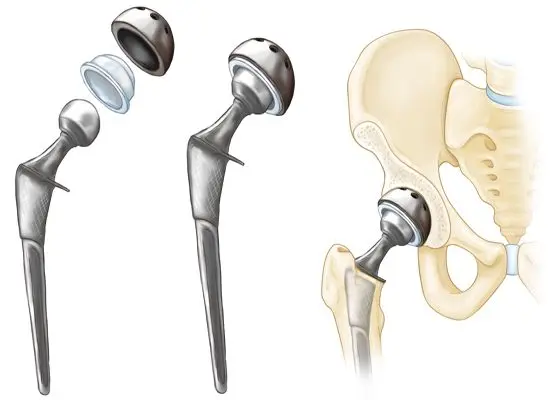Contents
Hip prosthesis
Nicknamed the “queen of orthopedic surgery”, the hip prosthesis is a very frequent and successful operation, even more with the development of operating techniques and equipment. This operation makes it possible to replace the hip joint when it is worn out, most often in cases of osteoarthritis, and thus to regain mobility and quality of life.
What is a hip prosthesis?
This procedure consists of replacing the hip joint with an artificial prosthesis, called a total hip prosthesis (THA). As a reminder, the hip is the joint between the pelvis and the femur. Major joint of the lower limbs, it is formed by a mold called acetabulum in which there is a ball called the femoral head. These two bone surfaces are covered with cartilage that promotes sliding and mobility of the joint.
How is the fitting of a hip prosthesis?
An operative assessment is carried out: consultation with an anesthesiologist and a cardiologist, blood test, specific X-ray to measure the dimensions of the necessary prosthesis.
The hip prosthesis is placed under general anesthesia or spinal anesthesia. The intervention lasts 1 hour to 1 hour 30 minutes.
An incision is made in the thigh, then the different muscle, nerve and tendon areas are delicately separated (and less and less severed, as was the case before) in order to reach the hip. The first step of the operation will be to remove the damaged joint areas. The surgeon intentionally dislocates the hip, in other words, he pulls the femoral head out of the acetabulum. Then he cuts the femoral head, the neck and the acetabulum.
Then comes the fitting of the prosthesis itself. This prosthesis has different elements:
- the cotyledon implant, a hollow hemispherical part implanted at the level of the acetabulum;
- a rod surmounted by a spherical head (the femoral head) implanted in the femur;
- a polyethylene or ceramic insert, placed in the acetabulum in order to act as a joint between the two parts.
Different materials (ceramic, polyethylene, various metal alloys,) and types of prostheses can be used. There are also different surgical techniques, the most recent being the so-called second-generation hip recurfacing (RH) technique. It consists in implanting on the femoral head a metal cup articulated with an acetabular cup.
The technique and the prosthesis will be chosen according to the age of the patient, his sporting activity, the presence or not of osteoporosis, the morphology of the hip, the quality of the femoral head, etc.
When should you consider having a hip prosthesis?
The hip prosthesis is offered in case of damage to the hip joint.
Osteoarthritis of the hip, or coxarthrosis, is the most frequent attack of this joint. Under the action of aging and physical constraints (overweight, repeated use), the joint is damaged and the cartilage deteriorates, causing pain in the hip and in the legs, stiffness, lameness when walking. The pains get worse: they then appear at rest, including at night, the walking perimeter gradually decreases, causing insufficiently stressed muscles to melt.
The wear of the cartilage being irreversible, only a replacement of the joint by a prosthesis, makes it possible to put an end to these problems which strongly impact the quality of life.
After the operation
Operative suites
Analgesic treatment is prescribed to limit the pain. Treatment is also prescribed to prevent phlebitis. The dressings, to be kept for about 3 weeks, are to be renewed every 2 to 3 days.
Hospitalization lasts on average 3 days, but sometimes this stay can be shortened to 24 hours, or even carried out on an outpatient basis with recent less invasive techniques, and if the patient does not present any risk factors (anticoagulant treatment, cardiac history, diabetes not stabilized, etc.).
Resumption of walking and sport
Walking can be resumed within 24 to 48 hours after the operation, helped and advised by the physiotherapist. The most recent surgical techniques allow an earlier resumption of walking, in the hours following the operation.
It is possible to practice a sporting activity with a hip prosthesis, on condition of resuming gradually in order to avoid a dislocation, the risk of which is increased in the first months after the operation, and to choose a sport that is not traumatic for the joints. Cycling or swimming is better than running. Contact sports and jumping sports are also not recommended.
The results
The hip prosthesis makes it possible to eliminate the pain when walking and at rest and to restore normal mobility of the hip. The patient’s quality of life is therefore greatly improved.
In recent years, many advances have been made both in terms of materials (ceramic, polyethylene, addition of zirconia) and techniques (double mobility for example), making it possible to improve performance (fixation to the bone, mobility, prevention dislocation) and the lifespan of the hip prosthesis. In the absence of complications, a hip prosthesis has an average lifespan of 20 years. The all-ceramic prosthesis is wear-resistant and does not damage the bone: it is placed for life and does not require re-intervention.
Hip resurfacing (RH) has many advantages over a conventional total hip prosthesis (THA): preservation of the femoral bone stock, respect for femoral biomechanics, no risk of dislocation of length inequality after resurfacing constitutes a major advantage compared to conventional prostheses, physiological proprioception, possible resumption of sports activities without restriction. This technique is preferred in young and / or athletic patients.
The risks of the operation
The intervention involves some risks:
- accidental fractures in cases of bone fragility;
- accidental damage to nerves and vessels.
After the intervention:
- hematoma ;
- the formation and migration of a blood clot which can lead to phlebitis or pulmonary embolism;
- infection of the surgical area;
- dislocation or displacement of parts of the prosthesis, requiring revision of the hip prosthesis;
- lower limbs of different lengths.










